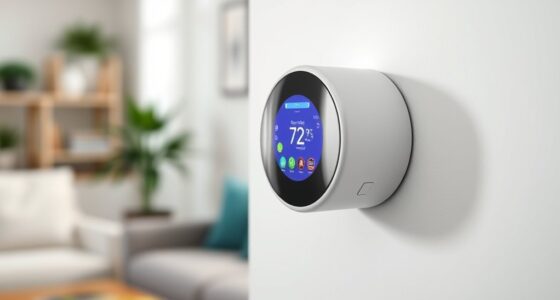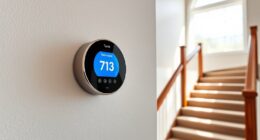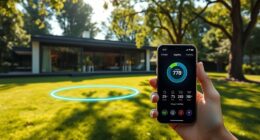To save energy during winter and summer, set your thermostat lower by 7-10 degrees during winter nights or when you’re away, and raise it a few degrees in summer when you’re not home. Use programmable or smart thermostats to automate these changes smoothly. With the right settings and technology, you’ll reduce energy costs while maintaining comfort. Keep exploring for more tips to optimize your seasonal temperature setbacks effectively.
Key Takeaways
- Lower your thermostat by 7-10°F during winter nights or absences to save energy without sacrificing comfort.
- Raise summer cooling temperatures by a few degrees when away or at night to reduce cooling costs effectively.
- Use programmable or smart thermostats to automate seasonal temperature setbacks tailored to your routine.
- Gradually adjust temperature settings instead of abrupt changes to maintain comfort while maximizing savings.
- Incorporate adaptive scheduling and weather-based adjustments for optimal seasonal energy efficiency.

Adjusting your thermostat with seasonal setbacks can considerably reduce energy costs, especially during the colder winter months and hotter summer days. By thoughtfully programming your thermostat, you can optimize your home’s temperature for seasonal energy efficiency without sacrificing comfort. This simple step allows you to lower heating settings during winter nights or when you’re away and raise cooling levels during the hottest parts of summer. The key is to find a balance that minimizes energy use while maintaining a comfortable environment.
Thermostat programming isn’t complicated, but it makes a big difference. During winter, you should lower your thermostat by about 7-10 degrees when you’re asleep or away from home. This setback prevents your heating system from working harder than necessary. Similarly, in summer, raising your cooling temperature by a few degrees when you’re not home can cut energy consumption substantially. Many modern thermostats allow for easy scheduling, so you can set different temperatures for different times of the day and week. This automation ensures you’re not wasting energy when you don’t need to heat or cool your home actively.
To maximize seasonal energy efficiency, consider adjusting your thermostat gradually instead of making drastic changes. Small, consistent setbacks—like lowering the temperature by 5 degrees in winter or increasing it by 5 degrees in summer—help you save without creating discomfort. Additionally, using features like adaptive scheduling or smart thermostat apps can automatically optimize temperature settings based on your routines and local weather forecasts. These tools help you stay ahead of fluctuating temperatures and prevent unnecessary energy waste. Incorporating modern heat pump technology can further enhance your home’s efficiency and indoor comfort year-round.
Frequently Asked Questions
How Do Setbacks Impact Indoor Air Quality?
Setbacks can impact indoor air quality by reducing air circulation and affecting indoor humidity levels. When you lower the thermostat, you might notice stagnant air and increased indoor humidity, which can lead to mold and allergens. To maintain good air quality, guarantee proper ventilation and monitor indoor humidity levels, especially during setbacks. This way, you keep your indoor environment healthy and comfortable even when adjusting your thermostat for savings.
Can Temperature Setbacks Cause HVAC System Damage?
Temperature setbacks won’t typically damage your HVAC system if used correctly, but improper setbacks can shorten its lifespan. Studies show frequent temperature changes can cause wear and tear, affecting system longevity. To prevent issues, guarantee your thermostat is well-calibrated and set setbacks gradually. Sudden or extreme temperature shifts strain components, leading to costly repairs. Properly managing setbacks helps protect your HVAC system, saving money and extending its life.
Are Setbacks Suitable for Homes With Elderly or Ill Residents?
Setbacks may not be suitable for homes with elderly or ill residents because maintaining consistent comfort is vital. Sudden temperature changes can affect elderly comfort and complicate illness management. If you choose setbacks, monitor your loved ones closely to make certain they stay comfortable and healthy. Consider adjusting setbacks to less extreme levels or avoiding them altogether during extreme weather, prioritizing health and comfort over energy savings.
How Quickly Can I Expect to See Savings From Setbacks?
Think of your savings like a garden blossoming—once you set the right thermostat calibration and choose the ideal setback duration, you’ll start noticing the fruits in a few days to a week. Cooler winter setbacks or warmer summer ones gradually lower energy use, but patience is key. Your system needs time to adapt, so keep an eye on your energy bills as they begin to shrink, revealing your smart savings journey.
What Are the Best Setback Temperatures for Energy Efficiency?
You should set your thermostat programming to 68°F in winter and 78°F in summer for ideal energy conservation. These setback temperatures balance comfort and efficiency, reducing energy use when you’re asleep or away. Adjusting your thermostat during these periods helps you save money and energy without sacrificing comfort. Regularly review and fine-tune your thermostat programming to maximize savings and guarantee you’re getting the most from your energy-efficient strategies.
Conclusion
By adjusting your thermostat for winter and summer setbacks, you’re not just saving energy—you’re nurturing balance and harmony within your home. Think of these settings as the quiet pauses in a symphony, allowing your system to breathe and work efficiently. Embrace these subtle shifts as small acts of care, symbolizing your commitment to sustainability and comfort. In doing so, you create a warmer, more harmonious environment, where energy savings flow as smoothly as a well-conducted melody.









